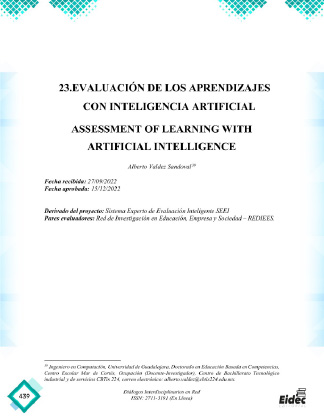XXIII. EVALUATION OF LEARNING WITH ARTIFICIAL INTELLIGENCE
##plugins.themes.bootstrap3.article.main##
Abstract
In the present work, results obtained from the system software are compared.
expert published by Sánchez et al. (2021) against the results produced by the System
Intelligent Evaluation Expert (SEEI). The latter is the update of the former, so
This document outlines the similarities and differences between the predecessor software
and the successor.
Both softwares use Artificial Intelligence (AI) to calculate on a scale of
zero to ten, the qualification resulting from a process of evaluation of the learning of
high school students in the Mexican context.
The objective of this research is to find validity in the SEEI instrument, since it
it evolved from its predecessor with intentions that it can be used by any
teacher, to evaluate any competence, in any subject, in any
educational institution located anywhere in the world just by having access to the internet.
The results give firm evidence that the line of research is on the right track.
and that it is worth continuing testing and adjusting SEEI and finding in the future,
validity in more contexts.
In this way, the computing power of the AI on the models would be reaffirmed.
rubric-based mathematics with which currently based learning is assessed
in competition and a new and promising era would emerge in which teachers will finally have
state-of-the-art assessment tools.
Download Statistics
##plugins.themes.bootstrap3.article.details##
Fuzzy Logic, Expert System, Evaluation, Competition, Rubric.
COMPETENCIAS EN EDUCACIÓN SUPERIOR: ¿USO O ABUSO?. Profesorado.
Revista de Currículum y Formación de Profesorado, 19(2),265-280.[fecha de
Consulta 5 de Septiembre de 2022]. ISSN: 1138-414X. Disponible en:
https://www.redalyc.org/articulo.oa?id=56741181017.
Del Canto, Ero, y Silva Silva, Alicia (2013). Metodología cuantitativa: abordaje desde la
complementariedad en ciencias sociales. Revista de Ciencias Sociales (Cr), III (141),
pp. 25-34.
Gutiérrez, A. & Ferreira, W. (2020). Un modelo de regresión lineal aplicando lógica difusa.
Revista Sextante, 23, pp. 48 - 54, 2020.
Hernández, R., Fernández, C., y Baptista, M. (2010). Metodología de la investigación (5th
ed.). México D.F.: McGRAW-HILL.
Jamsandekar, S., y Mudholkar, R. (2013). Performance Evaluation by Fuzzy Inference
Technique. International Journal Of Soft Computing And Engineering, 3(2), pp. 158-
164.
Martínez, J. (2008). Las rúbricas en la evaluación escolar: su construcción y uso. Avances en
Medición, 6, 129-138.
Monje, C. (2011). Metodología de la investigación cuantitativa y cualitativa. Guía didáctica.
Neiva: Universidad sur colombiana.
Picón Jácome, Édgar (2013). La rúbrica y la justicia en la evaluación. Íkala, revista de
lenguaje y cultura, 18(3),79-94.[fecha de Consulta 5 de Septiembre de 2022]. ISSN:
0123-3432. Disponible en: https://www.redalyc.org/articulo.oa?id=255030038006.
Sánchez García, J. E. ., Valdez Sandoval, A. ., Soto Vega, J. E. ., & Gutiérrez Herrera, B. E.
. (2021). Comparación del nivel de desempeño de una competencia usando tres
instrumentos, dos basados en rúbrica y otro basado en lógica difusa: A comparison of
the level of competency using three instruments; two rubric based instruments and a
fussy logic-based instrument. Revista Relep - Educación Y Pedagogía En
Latinoamérica, 2(4), 123–145. https://doi.org/10.46990/relep.2020.2.4.245.





